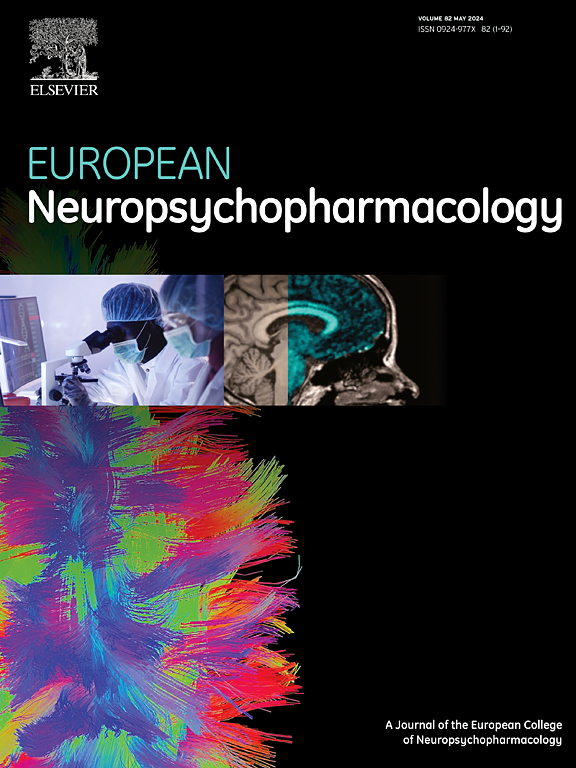equtl效应的多基因聚集揭示了细胞类型和性状特异性的远程调控模式
IF 6.7
2区 医学
Q1 CLINICAL NEUROLOGY
引用次数: 0
摘要
基因调控在不同的基因组区域和细胞背景下变化,由线性距离和三维基因组结构形成。最近对染色体22q和16p的研究表明,神经精神疾病——特别是精神分裂症(SCZ)、自闭症、多动症和低智商——的常见多基因风险与神经元细胞类型中这些染色体臂上基因表达的普遍减少有关。这些发现促使我们开发了一种可扩展的方法来研究全基因组范围内存在的远程调节模式的程度,以及这些模式是否特定于神经精神疾病或神经元细胞环境。为了系统地评估调控效应如何随着snp -基因距离的变化而变化,我们开发了一个多基因风险评分(PRS)启发的框架,该框架汇总了不同性状和细胞类型背景下由GWAS效应量加权的eQTL效应量。我们的初步分析成功地在四种神经细胞类型中复制了之前的22q发现:谷氨酸能和gaba能神经元、星形胶质细胞和少突胶质细胞。我们观察到,scz加权的eQTL效应在长达16 Mb的距离上始终为负,特别是在谷氨酸能神经元和星形胶质细胞中,高度加权的eQTL效应为零。少突胶质细胞在这两种性状背景下均表现为零效应。这些结果证实了长距离基因调控的性状和细胞类型特异性特征的存在。随后,我们在全基因组范围内扩展了分析,发现了许多在任何性状背景下都无法发现远程eQTL效应的基因组区域(例如chr4: 118Mb - 151Mb),以及少数基因组区域,在这些区域中,SCZ的常见变异风险(而不是体细胞性状)类似地下调了大基因组区域的基因(例如chr1: 1Mb - 33Mb)。正在进行的工作将纳入更多的大脑和非大脑细胞类型,并整合染色质接触数据,将空间基因组组织与观察到的调节模式联系起来。这些分析将进一步深入了解转录组基因失调如何造成SCZ和其他神经精神疾病的风险,以及多基因对精神疾病影响的生物学后果。更广泛地说,这种prs风格的eQTL聚合框架提供了一种可扩展的方法,用于识别遗传风险如何跨距离、细胞身份和疾病相关性影响基因调控。本文章由计算机程序翻译,如有差异,请以英文原文为准。
POLYGENIC AGGREGATION OF EQTL EFFECTS REVEALS CELL-TYPE AND TRAIT-SPECIFIC LONG-RANGE REGULATORY PATTERNS
Gene regulation varies across genomic regions and cellular contexts, shaped by both linear distance and 3D genome architecture. Recent work on chromosomes 22q and 16p revealed that common polygenic risk for neuropsychiatric disorders - particularly schizophrenia (SCZ), autism, ADHD, and low IQ - is associated with widespread decreases in gene expression across these chromosome arms in neuronal cell types. These findings motivated our development of a scalable method to investigate the extent to which long-range regulatory patterns exist genome-wide, and whether these patterns are specific to neuropsychiatric disease or neuronal cellular contexts.
To systematically assess how regulatory effects vary with SNP-gene distance, we developed a polygenic risk score (PRS)-inspired framework that aggregates eQTL effect sizes weighted by GWAS effect sizes across different trait and cell-type contexts.
Our initial analysis successfully replicated the previous 22q findings across four neuronal cell types: glutamatergic and GABAergic neurons, astrocytes, and oligodendrocytes. We observed that SCZ-weighted eQTL effects were consistently negative across distances up to 16 Mb, particularly in glutamatergic neurons and astrocytes, where height-weighted eQTL effects were null. Oligodendrocytes exhibited null effects in both trait contexts. These results confirmed the existence of trait- and cell-type-specific signatures of long-range gene regulation. We subsequently expanded the analysis genomewide, identifying many regions of the genome in which long range eQTL effects could not be identified in any trait context (e.g. chr4: 118Mb - 151Mb), and a small number of regions of the genome in which common variant risk for SCZ, but not somatic traits, was similarly downregulating genes across large genomic territories (e.g. chr1: 1Mb - 33Mb).
Ongoing work will incorporate additional brain and non-brain cell types, and integrate chromatin contact data to connect spatial genome organization with the observed regulatory patterns. These analyses will provide additional insight into how transcriptome-wide gene dysregulation creates risk for SCZ and other neuropsychiatric disorders, and the assign biological consequence to polygenic influences on psychiatric disease. More broadly, this PRS-style eQTL aggregation framework offers a scalable approach for identifying how genetic risk influences gene regulation across distance, cellular identity, and disease relevance.
求助全文
通过发布文献求助,成功后即可免费获取论文全文。
去求助
来源期刊

European Neuropsychopharmacology
医学-精神病学
CiteScore
10.30
自引率
5.40%
发文量
730
审稿时长
41 days
期刊介绍:
European Neuropsychopharmacology is the official publication of the European College of Neuropsychopharmacology (ECNP). In accordance with the mission of the College, the journal focuses on clinical and basic science contributions that advance our understanding of brain function and human behaviour and enable translation into improved treatments and enhanced public health impact in psychiatry. Recent years have been characterized by exciting advances in basic knowledge and available experimental techniques in neuroscience and genomics. However, clinical translation of these findings has not been as rapid. The journal aims to narrow this gap by promoting findings that are expected to have a major impact on both our understanding of the biological bases of mental disorders and the development and improvement of treatments, ideally paving the way for prevention and recovery.
 求助内容:
求助内容: 应助结果提醒方式:
应助结果提醒方式:


